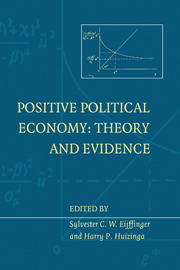Book contents
- Frontmatter
- Contents
- List of figures
- List of tables
- List of contributors
- Foreword
- Introduction
- I Monetary institutions and policy
- 1 Reputational versus institutional solutions to the time-consistency problem in monetary policy
- 2 Reciprocity and political business cycles in federal monetary unions
- Comment
- 3 The ultimate determinants of central bank independence
- 4 Central bank autonomy and exchange rate regimes – their effects on monetary accommodation and activism
- 5 Uncertainty, instrument choice, and the uniqueness of Nash equilibrium: microeconomic and macroeconomic examples
- 6 New empirical evidence on the costs of European Monetary Union
- II Exchange rate policy and redistribution
- Index
Comment
from 2 - Reciprocity and political business cycles in federal monetary unions
Published online by Cambridge University Press: 05 September 2013
- Frontmatter
- Contents
- List of figures
- List of tables
- List of contributors
- Foreword
- Introduction
- I Monetary institutions and policy
- 1 Reputational versus institutional solutions to the time-consistency problem in monetary policy
- 2 Reciprocity and political business cycles in federal monetary unions
- Comment
- 3 The ultimate determinants of central bank independence
- 4 Central bank autonomy and exchange rate regimes – their effects on monetary accommodation and activism
- 5 Uncertainty, instrument choice, and the uniqueness of Nash equilibrium: microeconomic and macroeconomic examples
- 6 New empirical evidence on the costs of European Monetary Union
- II Exchange rate policy and redistribution
- Index
Summary
This chapter is one of a series of papers that Jürgen von Hagen has written on the institutional features of monetary union. A central theme in his work on monetary union is the recognition that the long-run inflation performance of such a union depends critically on its political structure and its institutional set-up. The work seems also relevant for the current discussion about the optimal road toward European Monetary Union and the design of a European Central Bank.
Monetary unions typically have a federal structure with a central bank council consisting of state representatives of the member states, in some cases together with central appointees. An important question related to the functioning of a monetary union is the division of power over monetary policy between the center and the parts of the union and, hence, between state representatives, who are supposed to defend, in their voting behavior, their country's interests, and central appointees on the central bank council, who are supposed to take a more neutral stand.
Contributions to the literature on the optimal design of a monetary union include work by Alesina (1988), Alesina and Grilli (1993), Casella (1992), and, more recently, Von Hagen and Süppel (1994). The Von Hagen and Süppel paper is of particular interest here because this chapter builds on that paper. In the Von Hagen and Süppel (1994) paper it is shown how a division of monetary policy authority between state representatives and central appointees may work out.
- Type
- Chapter
- Information
- Positive Political EconomyTheory and Evidence, pp. 43 - 46Publisher: Cambridge University PressPrint publication year: 1998



